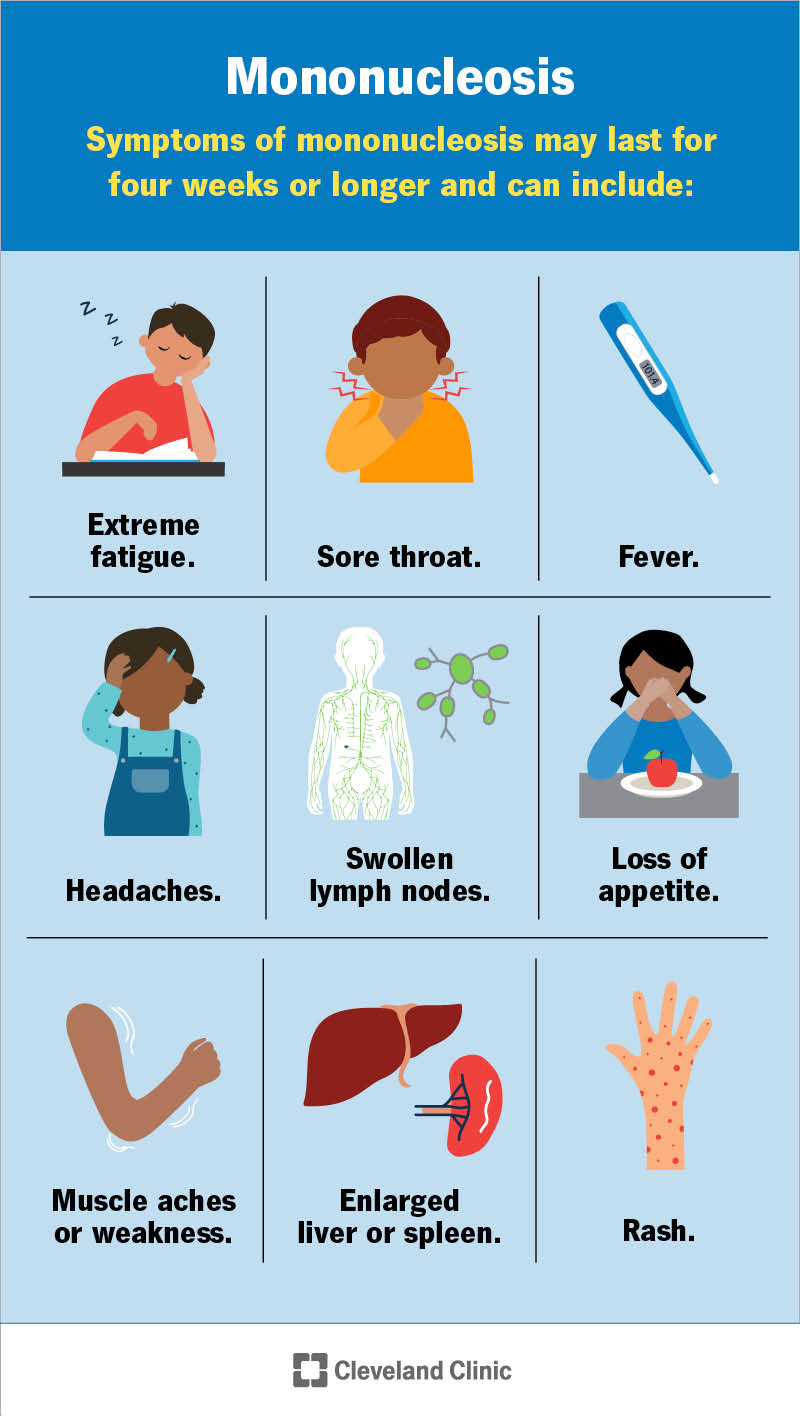Mononucleosis (mono) is a contagious infection caused by a herpes virus called Epstein-Barr. Other viruses can also cause mono. The infection is common among teenagers and young adults. People with mono experience extreme fatigue, fever and body aches. Treatments can ease symptoms until the illness goes away on its own.
Advertisement
Cleveland Clinic is a non-profit academic medical center. Advertising on our site helps support our mission. We do not endorse non-Cleveland Clinic products or services. Policy
Mononucleosis, or infectious mononucleosis (“mono”), is a very contagious viral infection that most commonly affects teenagers and young adults, but it can affect children, as well. Viruses — most often Epstein-Barr virus (EBV) — and certain infections cause the illness. Mono is sometimes called “the kissing disease” because it spreads easily through bodily fluids like saliva.
Advertisement
Cleveland Clinic is a non-profit academic medical center. Advertising on our site helps support our mission. We do not endorse non-Cleveland Clinic products or services. Policy
For most people, mono isn’t serious, and it goes away on its own without treatment. Still, extreme fatigue, body aches and other symptoms can interfere with school, work and daily life. With mono, you might feel sick for about a month.
The Epstein-Barr virus (EBV) that causes mononucleosis is extremely common. About 95% of Americans get this infection by age 35. But not everyone who has the virus develops mono symptoms — some people only carry the virus.

Mononucleosis symptoms vary, and they can be mild or severe. They tend to come on gradually. If you get sick with mono, it’ll probably happen four to six weeks after you come in contact with Epstein-Barr virus. These symptoms may last for four weeks or longer:
The Epstein-Barr virus causes over 90% of infectious mononucleosis cases. Other viruses and certain infections may also bring on the illness. The symptoms can develop because of:
Advertisement
Viruses that cause mononucleosis are very contagious. You can pick them up through contact with an infected person’s bodily fluids, including saliva. These viruses spread through:
Epstein-Barr is a type of herpes virus. It’s different than the herpes simplex virus (HSV) that causes genital and oral herpes. Both viruses can be sexually transmitted. However, EBV is more likely to spread through other means like sharing drinks or kissing.
The Epstein-Barr virus stays in your body in an inactive form even after mononucleosis symptoms go away. But most people develop mono only once.
If EBV reactivates, it rarely causes symptoms. However, you may unknowingly spread the reactivated virus to others. And people with weakened immune systems may develop mono symptoms more than once.
There are two peaks when people acquire EBV: early school-age children and again around adolescence/young adulthood. Young children often don’t have symptoms, whereas teenagers and people in their 20s are most likely to get mono. About 1 in 4 people in this age group who get EBV come down with mono, but anyone can get it, no matter their age.
Mononucleosis symptoms tend to gradually improve in about four weeks. Feelings of fatigue can linger for months. Some people miss some school or work as they recover.
An enlarged spleen that ruptures (bursts) is the biggest concern with mono in previously healthy people. This gland in your upper left abdomen (belly) helps filter blood. If your spleen bursts, it can bleed into your abdomen. Internal bleeding from a ruptured spleen can be life-threatening and requires emergency surgery.
To avoid a ruptured spleen, your healthcare provider may tell you to avoid strenuous exercise, contact sports and heavy lifting until you feel better.
Your healthcare provider will assess your symptoms to make a diagnosis. They’ll especially check for swollen lymph nodes in your neck and signs of an enlarged spleen or liver.
Blood tests detect antibodies that your body makes to fight the Epstein-Barr virus. Your provider may also check for a high number of white blood cells (lymphocytes) that indicate infection.
There isn’t a cure for mono. Antibiotics and antiviral medications that kill other viruses don’t work against mono. Instead, mononucleosis treatments focus on helping you feel better by relieving symptoms. Your self-care might include:
Advertisement
Mononucleosis symptoms can be severe. They may temporarily affect your ability to lead an active life. Fortunately, these symptoms gradually improve with at-home supportive therapy.
You may experience lingering fatigue for several months. You’ll need to protect your health by getting enough rest and fluids during this time. You should also avoid strenuous activities to prevent a ruptured spleen.
The best way to prevent getting the viruses that cause mono is by practicing good hygiene. Don’t share foods, drinks or bodily fluids with someone who has mono or any signs of viral illness, like fever, cough, sore throat or fatigue.
Advertisement
You should call your healthcare provider if you have mononucleosis and you experience:
If you have mononucleosis, you may want to ask your healthcare provider:
People who develop mononucleosis from EBV during pregnancy typically go on to have healthy pregnancies. Call your healthcare provider if you develop a fever, which can increase the risk of miscarriage and premature labor. There’s a slight chance you may pass the Epstein-Barr virus to your the developing fetus or a breastfeeding baby. But most babies don’t develop mono symptoms. If a CMV infection caused mono during pregnancy, there’s a chance it may affect the fetus and you should discuss this with your obstetrician.
Advertisement
Most cases of infectious mononucleosis (mono) don’t cause serious problems. But symptoms like extreme fatigue, sore throat and body aches can disrupt school, work and life. Your healthcare provider can provide suggestions for finding relief. Rest and over-the-counter medications are often the best ways to ease symptoms. It’s also important to avoid strenuous physical activity that may rupture an enlarged spleen.
Need care fast? Cleveland Clinic’s Express Care and Urgent Care locations treat everything from sprains to sinus infections — no appointment needed.

Last reviewed on 01/09/2024.
Learn more about the Health Library and our editorial process.